In a state that many people associate with tornadoes, the dust bowl, and a certain movie, the diversity of wildlife in Kansas may surprise you. For example, the “Sunflower State” is home to more than 40 snake species. You might see some of them in your garden, and it’s those species we’ll be discussing.
Snakes are creepy to many people, and some are terrified of them. However, we believe that knowledge is power, and we want to help ease your fears and reduce the amount of ophidiophobia (irrational fear of snakes) in the world.
Before you decide what to do with a snake, you must know whether it’s dangerous to your family and pets. So, we’re listing the most common venomous danger noodles with their descriptions first, followed by the nonvenomous garden helpers.
1. Copperheads

The Copperhead’s scales are keeled, and their eyes have vertical pupils that make them resemble cat’s eyes.
©Creeping Things/Shutterstock.com
By far the most common venomous snake in the eastern half of Kansas, copperhead snakes (Agkistrodon contortrix and Agkistrodon laticinctus) are highly adaptable and often live in and around human habitats like gardens, backyards, and under patios. These snakes are pit vipers, like rattlesnakes and cottonmouths, and have large heads that house venom glands and folding fangs typical of the group.
Like all pit vipers, copperheads have a heat-sensing pit on each side of their face, between their nostril and eye. As a result, they are the perfect nocturnal predator and have vertical pupils. Although in the dark, they depend more on their pits and tongue for locating prey.
One thing that many people say is that pit vipers like copperheads and rattlesnakes is that they look like they’re” angry at the world.” While this isn’t a technical identification, it does make sense when you know that this group of snakes has an extra scale that shades their eyes. It’s this feature that makes them look angry.
Copperheads are known for hiding in dry leaf litter and under bushes. They’re challenging to spot when they’re not moving, and while copperheads aren’t inclined to bite, these snakes will bite when they’re scared. So when you’re out in the garden, always take precautions before reaching into areas they may hide. Both copperhead species are common in the eastern and southeastern regions of Kansas.
Types of Copperheads in Kansas
Copperheads get their common name from their heads’ coppery or bronze color. Two copperhead species take up residence in areas of Kansas:
- Eastern copperhead (A. contortrix) snakes have thick bodies with markings that can take the shape of either an hourglass or a chocolate kiss, depending on your viewing angle.
- Broadbanded copperheads (A. laticinctus) look very similar but have broad bands that alternate between dark and light. Their base color ranges from gray to light brown, and their markings are brown to brownish-red, bordered with and have lighter centers that deepen to a darker brown at the edges.
2. Rattlesnakes
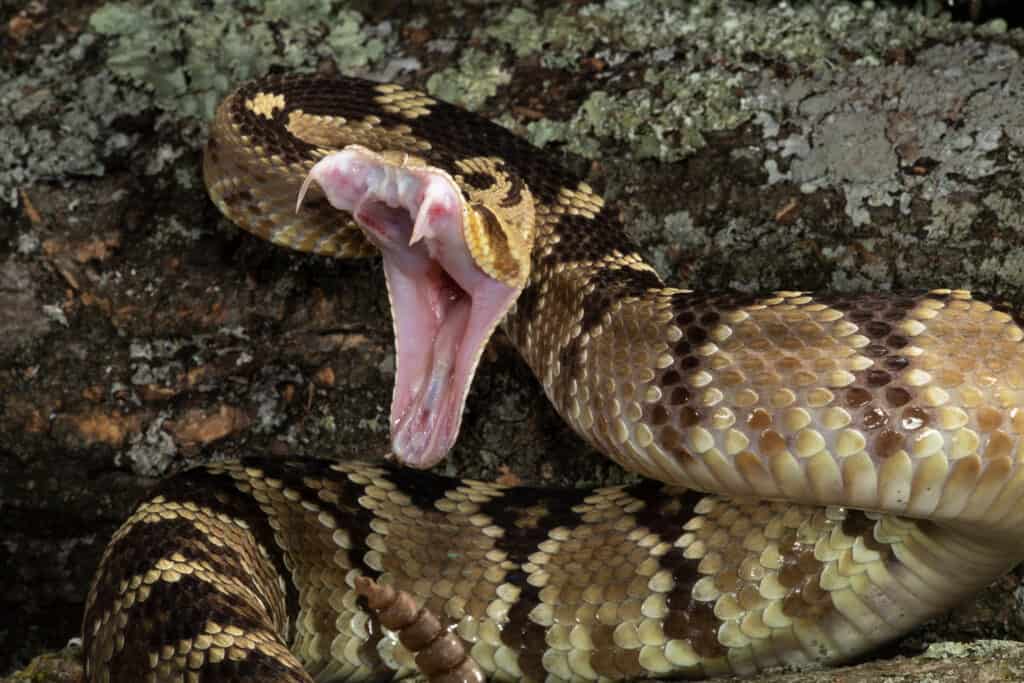
Rattlesnakes get their name from the rattle at the ends of their tails.
©Joe McDonald/Shutterstock.com
Buzz-tails, more commonly known as rattlesnakes, are relatively easy to identify. They have heat-sensing pits between their nostril and eye, and most species have large, angular heads with narrow necks. In addition, most species have a sort of “bandit mask” comprised of a dark stripe with a light-colored border that runs through their eyes.
Their venom-delivery system is highly developed. Scientists believe that vipers have the most developed of all venomous snakes. A rattlesnake’s fangs are hinged at the base and directly connected to large venom glands. They are nature’s hypodermic needles, designed to inject large quantities of venom very deeply into the victim. However, 25 and 50% of all bites are” dry,” meaning that the snake didn’t inject venom. Even so, a bite from any venomous snake requires medical attention – even if it’s only for observation. In addition, some people are allergic to their venom and must have epinephrine on top of the life-saving anti-venom.
The rattlesnake’s early-warning system may have developed as a preventive measure to avoid being stepped on by American bison, which once roamed throughout most of North America. These huge, lumbering bovines needed a loud warning to keep from flattening the relatively tiny reptiles. Rattlesnakes get their name from the rattle at the ends of their tails. They are formed of loosely interlocking scales that buzz when the snake shakes its tail. The sound is unmistakable. Once you’ve heard it, you can’t un-hear it.
Types of Rattlesnakes in Kansas
Rattlesnakes tend to keep away from people but sometimes conflict with people through their children, pets, and livestock near farms and in other rural regions. Making noise and giving the snake time to escape is typically enough to avoid a problem with a rattlesnake. Remember that rattlesnakes are cowards first and do not want a fight.
The state has four rattlesnake species that you may encounter. However, in the western region of Kansas, you’re most likely to encounter the prairie rattlesnake.
- Timber Rattlesnake (Crotalus horridus): Also called a canebrake rattler, these snakes inhabit the far eastern quarter of Kansas. However, only a few people see them because they’re timid. They can grow to four to six feet long and have a light base color with darker markings that resemble batwings on their backs. This species was used on the Gadsden flag partly because it inhabits all 13 original colonies.
- Prairie Rattlesnake (Crotalus viridis): This species is common in western Kansas and has a pale cream, tan or yellow base color with dark blotches on its back. Prairie rattlesnakes can reach five and a half feet long.
- Western Massasauga (Sistrurus tergeminus): Rarely seen and often mistaken for a juvenile of another species. Massasauga rattlers are only about two and a half feet long; their rattle sounds much higher-pitched than larger rattlesnake species, and some may have very small undeveloped rattles. They have round to oval markings lined in white on their back and a gray to a tan base color. These snakes are common in pockets in the eastern two-thirds of Kansas.
- Western Diamondback Rattlesnake (Crotalus atrox): Rare, only found in some southern counties. This snake is large, growing up to six feet long; it has diamond-shaped markings on its back and black and white bands on its tail.
3. Gopher/Bull Snakes
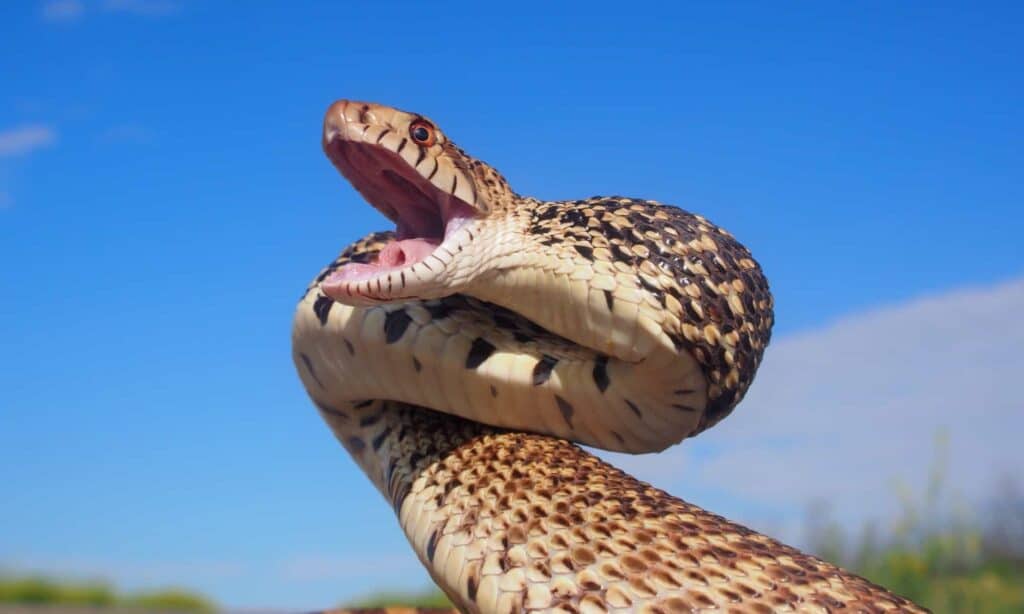
Gopher snakes are one of the most common snake species in Kansas.
©Markparker1983/Shutterstock.com
Nonvenomous gopher snakes (Pituophis catenifer) are also called bullsnakes. Gopher snakes are one of the most common snake species in Kansas. These harmless snakes are gardeners’ friends and eat all sorts of rodents that would destroy your crops. However, they’re not as shy as rattlesnakes and tend to be more diurnal in their habits.
These snakes are long and relatively thin; however, they have strong, muscular bodies and can reach nearly seven feet long. Their base color varies from straw yellow to brown, and they can also have some white on the neck and front part of their bodies. Over the base color, gopher snakes have darker-colored blotches. In addition, they have some spots on the sides that sometimes connect, forming a checkerboard pattern. Near the head, the blotches are darker and fade to reddish brown toward the tail.
Gopher snakes are common throughout Kansas and most of their natural range in North America. Their colors and patterns are similar everywhere they live; however, those in the southern and western parts of Kansas are more brownish overall.
4. Coachwhip (Masticophis flagellum)
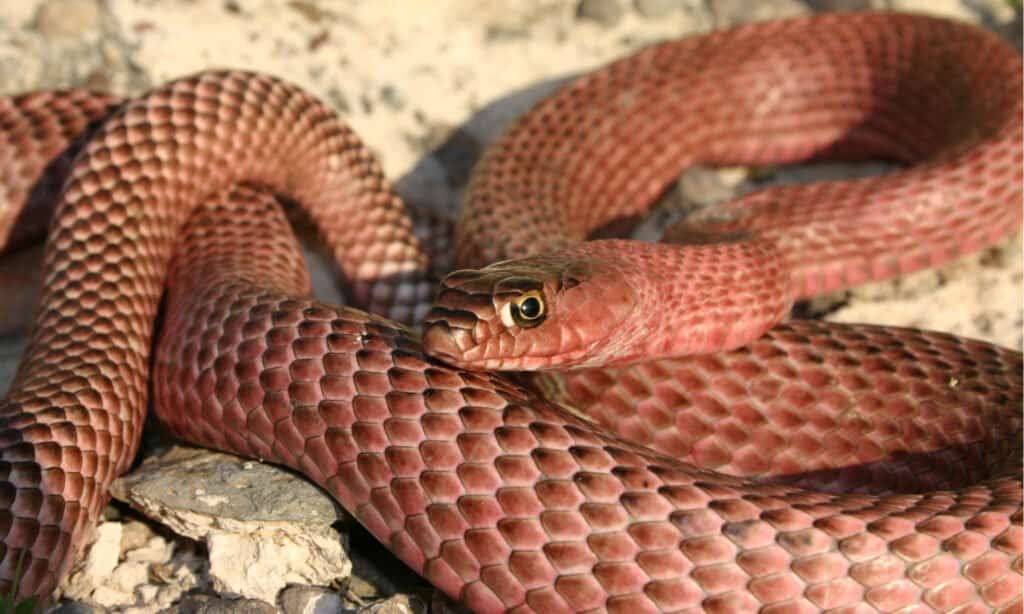
Coachwhips are active predators that move fast.
©Nathan A Shepard/Shutterstock.com
This species is similar to a racer, but they have a particular fondness for eating venomous snakes like rattlesnakes. Coachwhips are long and thin. Those in the west generally have coloration ranging from light tan to pale yellow or whitish. Coachwhips further east often have a two-toned color where the front half of their body is black, which fades to light brown or tan towards the tail. Dark edging in the light areas makes the snakes look like braided whips, giving rise to their name.
Coachwhips are common everywhere in Kansas except in the northeastern quarter of the state. They can grow over eight feet long, but the largest ever found in Kansas was just under six feet long, at 71 3/4 inches.
These snakes are active predators that move fast. They actively hunt their prey during the day, consuming other snakes, rodents, birds, amphibians, turtles, and insects. In addition, coachwhips are known for “periscoping” — they raise their heads above the surrounding vegetation or rocks while they look for food.
5. North American Racer (Coluber constrictor)

The North American racer is the most common snake in Kansas.
©Michael Chatt/Shutterstock.com
The next snake on our list is appropriately named. The North American racer is a fast-moving, always-on-the-go type of snake native to North America. It’s typically most active between April and November, and babies hatch in late summer.
Young racers have a light base color with darker blotches down their backs. The blotches have light edges and smaller spots on their sides. As they grow, they become darker and lose much of the juvenile pattern. Adults are usually blue-gray or greenish-blue, but some rare individuals are dark brown, olive, black, or tan. They almost always have yellow to cream-colored bellies with no pattern.
Racers are harmless snakes that can live just about anywhere. They have large, friendly-looking eyes and eat rats, mice, small birds, and other small animals. They’re most active during the day, so they’re seen frequently. Racers are not endangered and very common, making the North American racer the most common snake in Kansas.
Other Kansas Snakes
Kansas boasts several other snake species too. Aside from the racers and gopher snakes, there are at least 40 snake species native to the state. Here are a few:
- Cottonmouth or Water Moccasin (Agkistrodon piscivorus): This venomous danger-noodle is rare and confined to the far southeast corner of the state. They’re sometimes confused for their close cousins, the copperhead snakes.
- Prairie Kingsnakes (Lampropeltis calligaster): Found in the eastern two-thirds of the state.
- Western Ratsnake (Pantherophis obsoletes): Fairly common in the eastern half of Kansas, these snakes are known for getting themselves into predicaments.
- Speckled Kingsnake (Lampropeltis holbrooki): These beauties are found statewide in open woodlands and prairies but tend to avoid people.
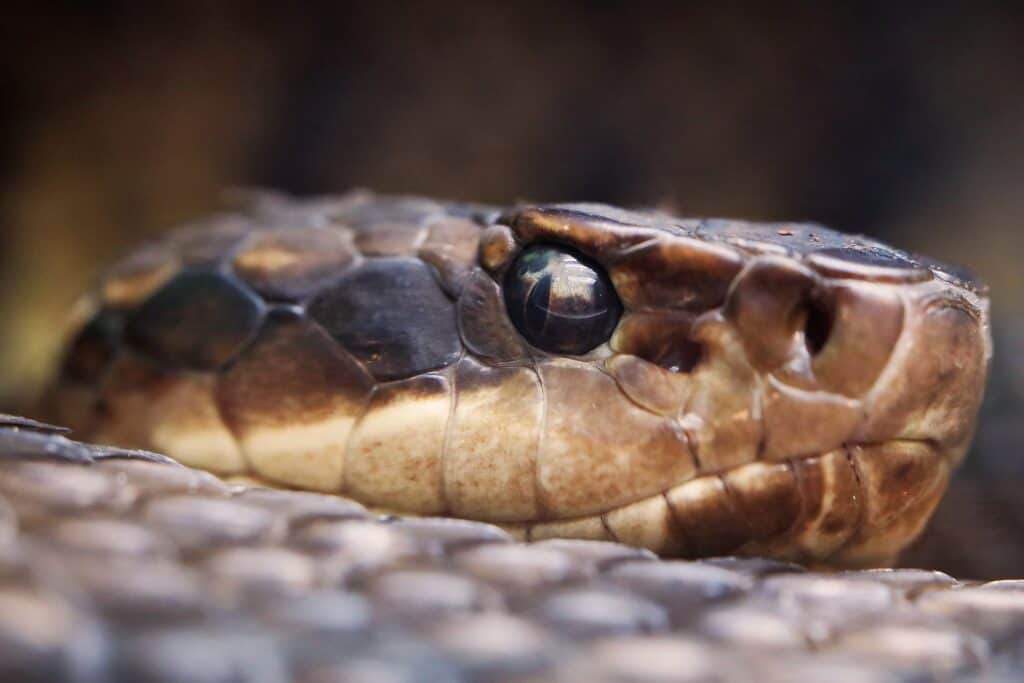
The cottonmouth is rare and only found in the far southeast area of Kansas.
©Nicole Ramsey/Shutterstock.com
Black Snakes of Kansas
Some other snakes in “The Sunflower State” include black snake species the western worm snake, northern watersnake, western ribbon snake, and plainbelly watersnake.
Western worm snakes are nonvenomous, grow 7.5-14.8 inches long, and make good pets. Northern watersnakes can reach 2-4.5 feet and although they are nonvenomous, they will bite or spray excrement and musk to defend themselves from predators. Another nonvenomous snake is the western ribbon snake, a species of garter snake, that measures 16-35 inches, is typically found in streams and lakes, and can make a great pet. One more nonvenomous species is the plainbelly watersnake, which is present in Kansas City’s lakes and rivers and shorter than northern water snakes measuring from 24 to 40 inches. Check out more information about black snakes here.
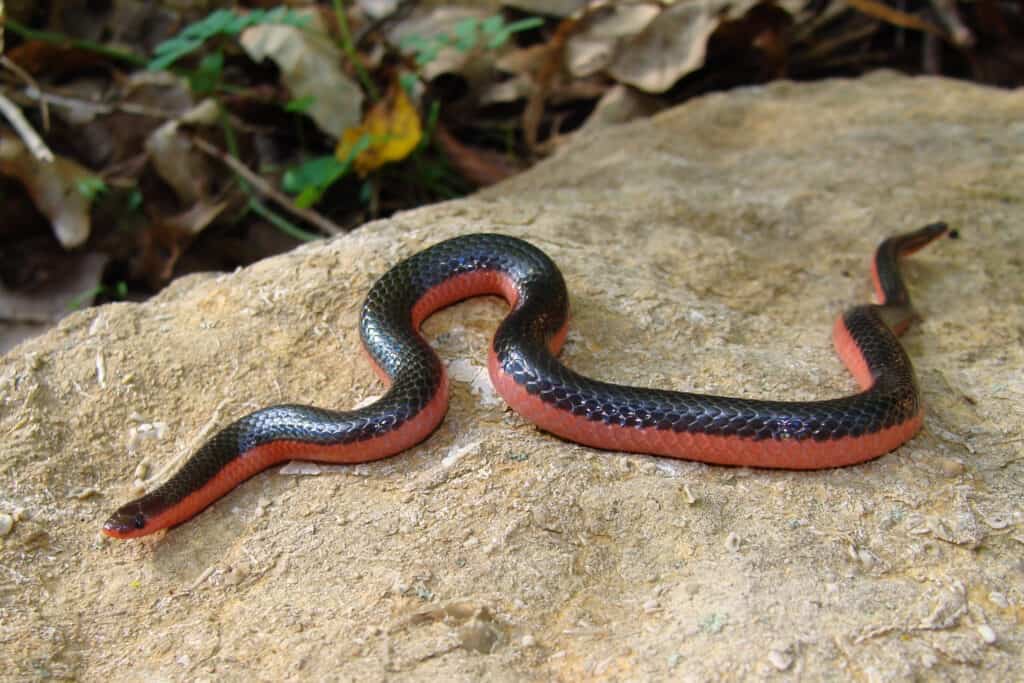
Western worm snakes are one type of nonvenomous snake in Kansas.
©Matt Jeppson/Shutterstock.com
Attracting or Repelling Snakes
If you prefer to keep snakes out of your yard and garage, the best thing to do is remove any convenient hiding spots. Take the time to remove brush piles and move firewood stacks further from the house. You can also keep high-traffic areas clear of debris and the lawn mowed. Also, check outside your home for any openings a rodent can use to enter. If you take these steps, most snakes will go elsewhere.
Next Up
- Discover the largest timber rattlesnake ever recorded
- Discover the longest coachwhip ever recorded
- Can you spot the copperhead hiding in plain sight?
The photo featured at the top of this post is © iStock.com/johnaudrey
Discover the "Monster" Snake 5X Bigger than an Anaconda
Every day A-Z Animals sends out some of the most incredible facts in the world from our free newsletter. Want to discover the 10 most beautiful snakes in the world, a "snake island" where you're never more than 3 feet from danger, or a "monster" snake 5X larger than an anaconda? Then sign up right now and you'll start receiving our daily newsletter absolutely free.
Thank you for reading! Have some feedback for us? Contact the AZ Animals editorial team.






